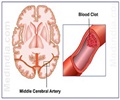Dental X-rays or panoramic radiographs can be effective in detecting blocked carotid artery that may increase the risk of having a
Dental X-rays or panoramic radiographs can be effective in detecting blocked carotid artery that may increase the risk of having a stroke.
Researchers from Virginia Commonwealth University School of Dentistry have reported that panoramic radiographs taken to find out about the oral health of the patient can show some cases of carotid artery stenosis or blocked carotid artery in the patient.The dentists to observe the entire structure of the mouth, like a patient’s teeth, roots, jaw and facial position, use the Periapical or bitewing radiographs, or the panoramic radiographs. The Periapical or bitewing radiographs are used to diagnose the extent of periodontal disease, bone infections and certain abnormal growths like cysts and tumors. These images are also used to reveal in great detail the upper and lower teeth along with the part of the jaw as well. The X-ray image also reveals the carotid arteries, as they pass through the region of the neck. The artery blockages usually come out in the images as white patches and spots.
The researchers feel that the study brings into focus the role the dentists play in determining the overall health of the patients and not just limited to taking care of their oral health.
Reference: Academy of General Dentistry, Press release, July 2005











